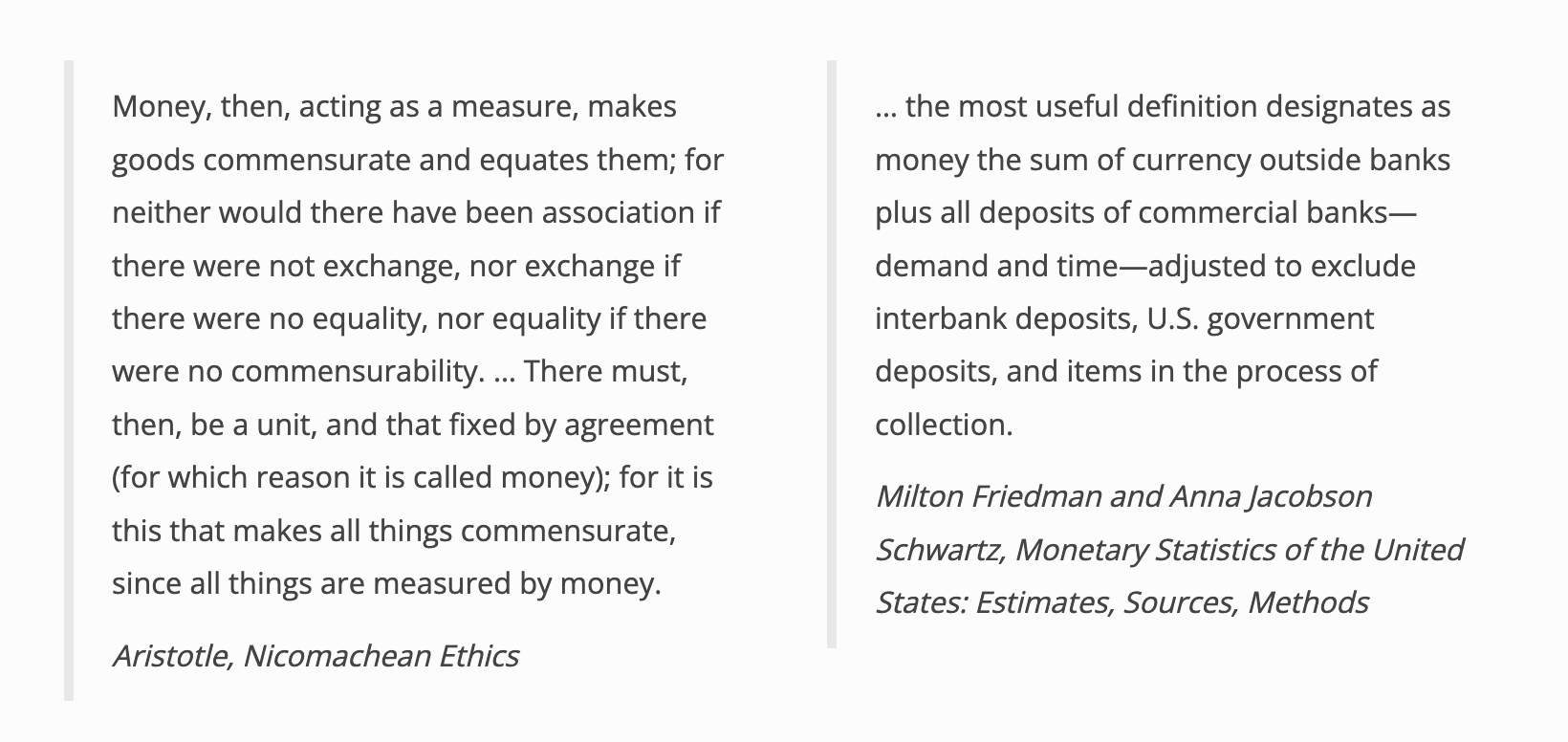Comments
- No comments found

Money might be the most misunderstood topic in finance.
Everyone knows exactly what it is, yet definitions greatly vary. Most reduce money’s meaning to some combination of the four functions famously stated by William Stanley Jevons in his 1875 essay Money and the Mechanism of Exchange: a medium of exchange, a common measure of value, a standard of value, and a store of value. Yet, defining money as all makes no logical sense.
Definitions play a critical role in human cognition. They allow us to economically grasp vast quantities of information. Thus, our understanding of the world is only as good as our definitions. Perhaps our slipshod approach to money explains the confused state of economics. We’d benefit from a more logically consistent view.
Money’s meaning has been debated for millennia. Scores of intellectuals from Aristotle to Milton Freidman defined it differently. You’d think that such a foundational concept would be consistently constructed. After all, physicists don’t debate water’s proper definition. Water’s universally accepted as a colorless, odorless, substance comprised of two hydrogens and one oxygen atom that can exist in three phases at different temperatures and pressures. Money does not enjoy such consensus. Economists define money in combinations of a common measure of value, medium of exchange, and store of value. For example, Jevon viewed money as both “the measure and standard of value and the medium of exchange”; Ludwig von Mises called it a “… medium of exchange which is commonly used …”; John Maynard Keynes ascribed a savings component to it, while Milton Friedman saw it as the sum of currency and various bank accounts. Rarely do economists agree.

Money’s meaning has been debated for millennia by scores of intellectuals. It’s never enjoyed a common definition, and not for lack of trying.
Money’s conflicting definitions lead us to contrasting conclusions. Some people view money as a commodity, while others see it as debt; some think money is created by the government, while others see it as endemic to trade; some even believe that banks arbitrarily create it from nothing aided by accounting tricks!
Somehow, these contradictions peacefully coexist within the field of economics. Practitioners seem to rotate through definitions, drawing upon whichever one suits their current needs. When it comes to money, there’s no consistency. Yet, how can this be? You don’t see similar behavior in other sciences. It violates basic logic!
Humans are conceptual beings. We construct abstract ideas to employ in our daily lives in ways that other animals can’t. Absent this gift, our ancestors would have perished eons ago. Superior cognition more than made up for their lack of impressive physical attributes such as claws, strength, or exceptional sense perception. Thinking enabled humans to thrive.
Definitions empower conceptual thinking. They condense many concepts into a single word, vastly expanding our mental capacities. The word water, for example, conveys boundless information about that seemingly simple substance. It describes its color, molecular structure, properties and behaviors at different temperatures and pressures, interactions with other matter, role in biological life, etc. “Water” portrays all of these traits with just one word.
Ultimately, definitions dictate action since they house the knowledge by which we act. Thus, we’re only as good as our definitions.
We form knowledge in a specific, hierarchical fashion. Direct observations (a.k.a. percepts) sit at the base of the knowledge hierarchy. Our senses perceive them without the need for interpretation. This object feels cold. That tastes sweet. Percepts are self-evident. They simply are. Yet, human knowledge extends beyond the perceptual level. We can integrate multiple percepts into simple concepts and then simple concepts into more complex ones in an ever-expanding body of knowledge.
Take the concept of furniture, for example. We can’t observe “furniture” directly. There is no such object to see or touch. Furniture is an abstract concept. Rather, we perceive various furniture items such as desks, beds, and couches. These furniture constituents are each a concept in their own right. There is no one bed. Beds come in different shapes, sizes, and configurations. There are twin-sized beds, king-sized beds, toddler beds, bunk beds, futons, and even hammocks! None look exactly the same, yet they share a similar trait that conceptually groups them together. Bed is a concept integrated by its function; they are dedicated and man-made surfaces specifically constructed for sleeping.
This hierarchy structure is both powerful and dangerous. It allows for the boundless storage of knowledge. Nesting concepts enables us to mentally grasp lots of information efficiently. The simple concept of furniture applies to an infinite number of concrete instances. We need not memorize them all; just furniture. How easy!
However, this codependency of concepts creates potential failure points in our knowledge. Err with one concept and all dependent, higher-order ones will be faulty too! Imagine wrongly conceptualizing bed as any place someone sleeps. This subtle difference would mistakenly categorize floors, sleeping bags, benches, airplane seats, and other things as beds. Such an error would render bed as conceptually useless. “Make your bed” could then mean tidying your sheets, sweeping the floor, or vacuuming the car’s interior. What use is that? Furthermore, the concept of furniture degrades into nonsense. Would a furniture store sell floors, sleeping bags, airplane seats, desks, and couches? What then happens to the concept of “home goods” which includes furniture among other household items like dishes, décor, and linens?
Thus, knowledge requires meticulous concept formation, in any subject. The entire conceptual chain should be auditable back to the perceptual level.
Definitions serve to differentiate concepts from each other. Thus, they cannot be arbitrary. Rather, effective definitions connote the essential characteristics of the concepts they describe. They observe the rule of fundamentality. Definitions must convey distinctive characteristics only.
For example, defining a man as “a mammal with a thumb” violates the rule of fundamentality. While humans do have thumbs, this is not our essential feature. Many mammals have them, like monkeys. What separates humans from other animals is our minds. Man’s definition must reflect this. Defining us as “the rational animal” more closely observes the rule of fundamentality.
While market participants accept money’s four common functions as equally valid—a medium of exchange, a common measure of value, a standard of value, and a store of value—logically, they are not. They differ in fundamentality. Three of them cannot be constructed without the existence of one: a common measure of value.
Transactions occur when two parties—a buyer and a seller—trade goods and services. This can take the form of barter or, (much) more commonly, using a medium of exchange. Historically speaking, mediums varied greatly. Commodities like copper, salt, pepper, shells, beads, and livestock played the role in some cultures. Others recorded debts with clay tablets or notched wood. Coins of various compositions—from precious metals to inexpensive government tokens—also mediated exchange. Regardless of the settlement form, all transactions exchange a specified quantity of value recognized by both buyer and seller. They agree on a price based on a measure of value common to both. Exchange is impossible without this language.
Storing value, too, first requires its recognition. This becomes evident when choosing a medium to use. There are many potential items with which one can store value. Yet, humans gravitated to some, like gold for example, rather than others, like milk. They worked best. Yet, to see this we must first grasp the concept of value. Otherwise, there’s no way to differentiate among choices. How else could you choose?
Thus, a common measure value is a more fundamental concept than a medium of exchange and store of value. Both utilize a common measure of value in their own formations. Worth must first be quantified in some mentally graspable form before it can be exchanged or stored. Similarly, a standard measure of value is a specific instance of a common measure of value whereby the latter becomes the former either by convention or statutory decree.
Obeying the rule of fundamentally reveals a common measure of value as money’s one and only definition. Therefore, its other ascribed functions are separate, derivative concepts that sit downstream from money. A medium of exchange is currency; a store of value is savings, and; a standard measure of value is a monetary standard. None are money. All use and require money’s existence.
Of course, proper definitions require more than logic to be valid. They must correspond to reality. After all, definitions don’t exist for their own sakes. They are our primary survival tool.
Evidence supports separating money’s four functions into distinct concepts. As noted above—and more extensively here and here—currencies and savings vehicles typically differed from the common measure of value throughout history.
Humans routinely tracked prices and debts in terms of money yet often transacted in various currencies. For example, the Sumerians in Mesopotamia recorded debts in shekels (standard weights of silver) yet settled them with other items; French kings in the time of Charlemagne kept accounts in Roman money though only local currencies circulated; early, colonial Newfoundland fishermen swapped dried fish for supplies even though values were calculated in pounds; ancient Greek coins traded by their stated denominations despite greatly varying in metallic composition. Even today, we discuss value in terms of dollars, euros, and yen and mediate exchange with credit cards, paper currencies, and even bonds.
Wealth, of course, is stored in many vehicles. We buy stocks, bonds, real estate, diamonds, gold, etc. for the purpose. Rarely do we save by hording conventional money-items like cash.
Logic and observation align. Money’s properly defined as a common measure of value.
Today, money suffers from many and conflicting definitions. This leads to drastically divergent views in economics and finance. While investors thoughtlessly accept most, such behavior violates basic rules of logic. Concepts can’t contradict.
Humans are conceptual animals. We survive by the use of our minds, pyramiding concepts upon each other to create knowledge in an organized hierarchy. Definitions are one of our most powerful tools. They allow us to retain vast quantities of knowledge in a mentally-efficient fashion. Thus, definitions are not arbitrary. They must conform to logic and reality to be useful.
Unfortunately, most definitions of money don’t. Defining money as a common measure of value, however, does. Money’s other commonly ascribed functions are the separate concepts of currency (medium of exchange), savings (store of value), and monetary standards (standard measures of value).
Clarifying and solidifying money’s definition has severe implications for many economic theories. Due to the hierarchical structure of knowledge, changing money’s meaning renders much of it worthless. Theories built from a faulty view of money will necessarily err. Thus, entire doctrines of economics must unfortunately be scrapped. While this may seem harsh, it’s the only way to properly build knowledge and save economics’ reputation as a serious science.
For some reason, we are not ready to depart with our beloved—yet wrong—definitions of money no matter how far astray they lead us. This unwillingness only perpetuates economics’ comical reputation. Science uncovers the way in which the world works. It does not conform to our whims or desires.
We must treat money’s definition with due respect. The stakes are high. Saving it will only help us save and invest better.
Seth Levine is a professional, institutional investor focused on selecting high yield bond positions for a financial services company. He is also the creator of The Integrating Investor where he blogs about macroeconomic and investment strategy related themes. Seth holds a Bachelor of Science degree in Mechanical Engineering from Cornell University and is a CFA charterholder. You can learn more about Seth at www.integratinginvestor.com and follow him on Twitter at @SethLevine2. Please note that any opinions and views he expresses are solely his own and do not reflect those of his current or former employers.
Leave your comments
Post comment as a guest